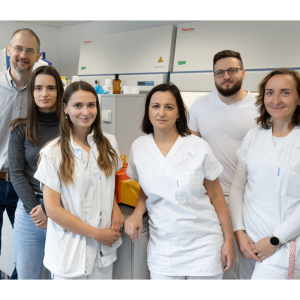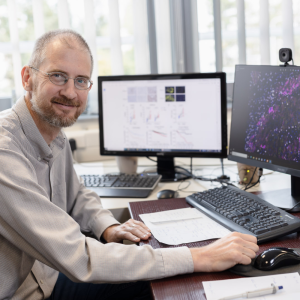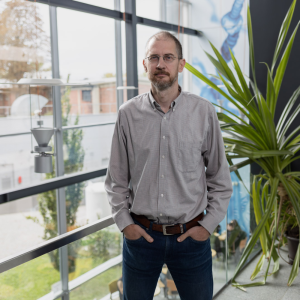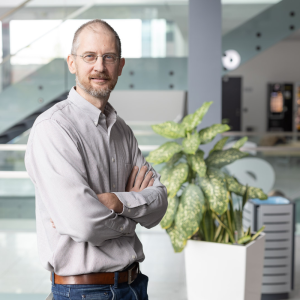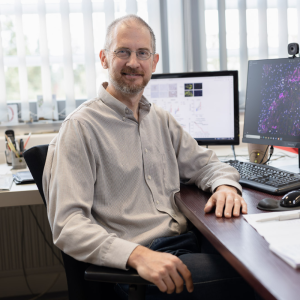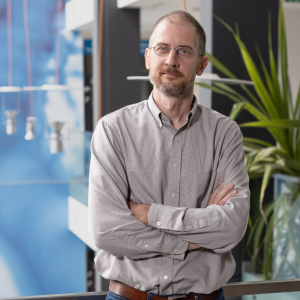
There is no doubt that pathologists, who must be familiar with the dynamically increasing understanding of all human organs, tissues, and cells, play an irreplaceable role in cancer research. This is clearly exemplified by the research team of Jan Bouchal, head of the Laboratory of molecular pathology at the Faculty of Medicine of Palacky University in Olomouc. This lab is part of the NICR and its aims on the identification of new prognostic and predictive biomarkers in liquid biopsies of patients with disseminated tumours, especially metastatic carcinomas of the prostate.
-
The motto of our research group is ‘Pathology – the smart beauty of medicine.’ To start with, allow me a personal question: how did your relationship with this beauty start and develop? And by the way, were you initially attracted to its beauty or its intellectual aspect?
Pathology entered my life 28 years ago, when Dr Bořivoj Vojtěšek recommended it to me during the last year of study of molecular biology and genetics in Brno. My main mentor is, and has been, Professor Zdeněk Kolář, who created the Laboratory of molecular pathology in 1995. This lab is based on a close collaboration of biologists and pathologists, who are tasked mainly with diagnostic work for the Olomouc University Hospital but also further afield. Their role is crucial, because patients’ further treatment depends on their erudition and correct evaluation. Pathologists are really brilliant because they must be familiar with our dynamically developing understanding of all organs of the human body, tissues, and cells. Doubtless there is also the sheer beauty of knowledge in it. So, on the one hand, the motto is quite daring but then again it expresses my deep respect to this demanding field.
-
Your team and you work on identifying new prognostic and predictive markers in the liquid biopsies of patients with metastatic tumours. What kinds of tumours do you focus on and why?
In the long term, we have been studying tumours of the prostate in collaboration with both urologists (especially Dr Milan Král) and oncologists (especially Dr Hana Študentová). With Karel Souček, we have conducted a number of studies also within the framework of the NICR. Both of us dealt with this disease during our postdoc, Karel in California and I in Innsbruck.
Prostate cancer is the most frequent cancer type in men and its prognosis is generally good, especially in localised disease that can be treated by removal of the prostate or by radiation. What is problematic are disseminated tumours. Their prognosis and treatment are still unsatisfactory. Within a project of the Czech Health Research Council and NICR we took plasma samples from over 300 patients with a metastatic disease. The work of our doctoral student Eva Chrenková on important predictive markers is now in the reviewing process.
Liquid biopsy naturally has a potential in most cancers, both for early diagnosis and in terms of selection and monitoring of the treatment. In view of the demanding logistics of sample collection and the need to precisely supplement clinical data, we prefer to focus on prostate cancer – and our collaboration with Dr Študentová, the vice-head of the department, is outstanding!
-
Another area your research team focuses on is the multiplex immunohistochemistry of candidate biomarkers in patients’ tissue samples. Where do you think the development is heading in this area?
The ability to distinguish between individual cell types in real issues adds a new dimension to our understanding of not only tumour biology. Numerous studies investigated the immunophenotyping of tumours, which plays a significant role in predicting response to immunotherapy. Recently, we have also seen the arrival of several instruments that enable the analysis of dozens of proteins within one and the same tissue section. Due to their price, their accessibility is so far limited but we have managed to get one on loan and our doctoral student Romana Hendrychová is using it for highly demanding analyses. Still, to analyse fewer proteins one can use a cheaper approach based on a tyramide signal amplification and a common fluorescence microscope.
-
You also test potential therapeutics in 3D patient organoids and in short-term ex vivo tissue samples. Who are your main collaborators in this aspect of your work?
It is far from trivial to cultivate 3D organoids and although they are a better model than the classic 2D models, they still do not fully represent real tissues. For short-term testing of new drugs or molecules, what is surprisingly effective is a simple cultivation of native tissue slices. For three to four days, all cell types remain vital and maintain their original interactions. In collaboration with colleagues from NICR, in particular Karel Souček and Radek Jorda, and also for some external companies, we have conducted a testing using tissues of the carcinoma of prostate, lungs, pancreas, and colon – naturally with patients’ informed consent and after receiving an approval from the ethics committee.
-
Which results of your research have already found their way into clinical practice?
According to our multivariate analysis, elevated levels of miRNA-375 predict an earlier failure of the ARPI (androgen receptor pathway inhibition) treatment in patients with castration-resistant prostate carcinoma. In patients with metastatic disease that is sensitive to hormone treatment, simple evaluation of platelet levels fulfils this function. We continue in these analyses in collaboration with Dr Študentová. Previously, we have also used qRT-PCR to assess the levels of urine markers for a more precise indication of prostate biopsy. Currently, urologists can use magnetic resonance to this purpose. Many of our studies deal with basic research and their citation levels make us proud.
-
Could you tell us about some of your domestic and international collaborations that we, in your view, especially important?
In the long term, we collaborate most closely with Karel Souček from the Institute of Biophysics of the CAS in Brno. With our colleagues from Brno, Professor Jan Vondráček and Dr Miroslav Machala, we are now finishing the second Czech Health Research Council project that focused on lipidomics in colon cancer. In Olomouc, we have the great advantage of a close link between the medical faculty and the university hospital, which makes the processing of tissue samples very fast and effective. What is also important is the support of BBMRI, a large biobanking research infrastructure, in which we participate thanks to Marián Hajdúch and Jiří Drábek.
Of international collaborations and mentors, I would like to thank especially Kjell Elgjo from the Rikshospitalet Oslo, Paul G. Murray from the University of Birmingham, Zoran Culig from the Innsbruck Medical University, and Jiří Bártek from the Danish Cancer Institute. It is remarkable how their impressive achievements contrast with their modesty in regular communication and how much they support the initiative of their younger colleagues.
-
Does the NICR consortium contribute to a further development of your scientific collaborations?
Ever since the first joint conference in which we participated as organisers I have been delighted with the opportunity to meet other research teams, have informal discussions, and develop collaborative efforts. NICR has also brought a level of financial stability, which is important for keeping young researchers within our field.
-
In the past, you have run in Dr Procházka’s team for the function of vice-dean of the Faculty of Medicine of the Palacky University for doctoral study programmes. What do you think should be done to further develop good doctoral programmes in the Czech Republic?
Students who are not physicians need aside from their stipend also part-time employment. What is also important is both professional and personal support of their supervisor, such as I have received from Professor Kolář. And what is of key importance is personal initiative, communication with other research groups, and willingness to search for one’s own way. On this subject, I especially liked the NICR interview with Professor Vítězslav Bryja, who is definitely an optimist regarding the development of doctoral programmes and science in the Czech Republic.
-
Do you think that NICR can make a significant contribution in this area?
Definitely! It meets all of the abovementioned desiderata: some financial stability, interaction with other top teams in the Czech Republic, and the opportunity to visit foreign laboratories.
-
You are heading a research team, do your own research, and work as head of the Institute of Clinical and Molecular Pathology of the Faculty of Medicine of the Palacky University and University Hospital Olomouc. Is it difficult to manage and balance all these roles?
It is a challenge but also honour I got from my fellow pathologists that I can cooperate with them at this position. The routine diagnostics is managed by Daniela Skanderová and teaching is coordinated by Daniela Kurfürstová and Zdeněk Kolář. Due to high work load, physicians often lack dedicated time for research, which is a pity. Especially since the role of pathologists in tumour research is irreplaceable.
-
And finally, with a grain of salt: pathology is medicine without patient contact. Don’t pathologists feel a bit lonely at work? ☺ What do you do in your time off?
Our team includes over sixty people, physicians, biologists, and lab technicians, so it can get quite busy here! Moreover, physicians often discuss their findings with clinicians, so they do have interaction with patients. It is mediated but very important. Concerning the latter, my wife, children, and I like the mountains, hiking, cross country skiing, and biking. On top of that, I have inherited from my father some bees and care of a garden in a village where I grew up.


